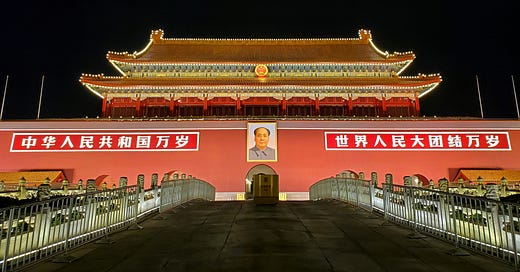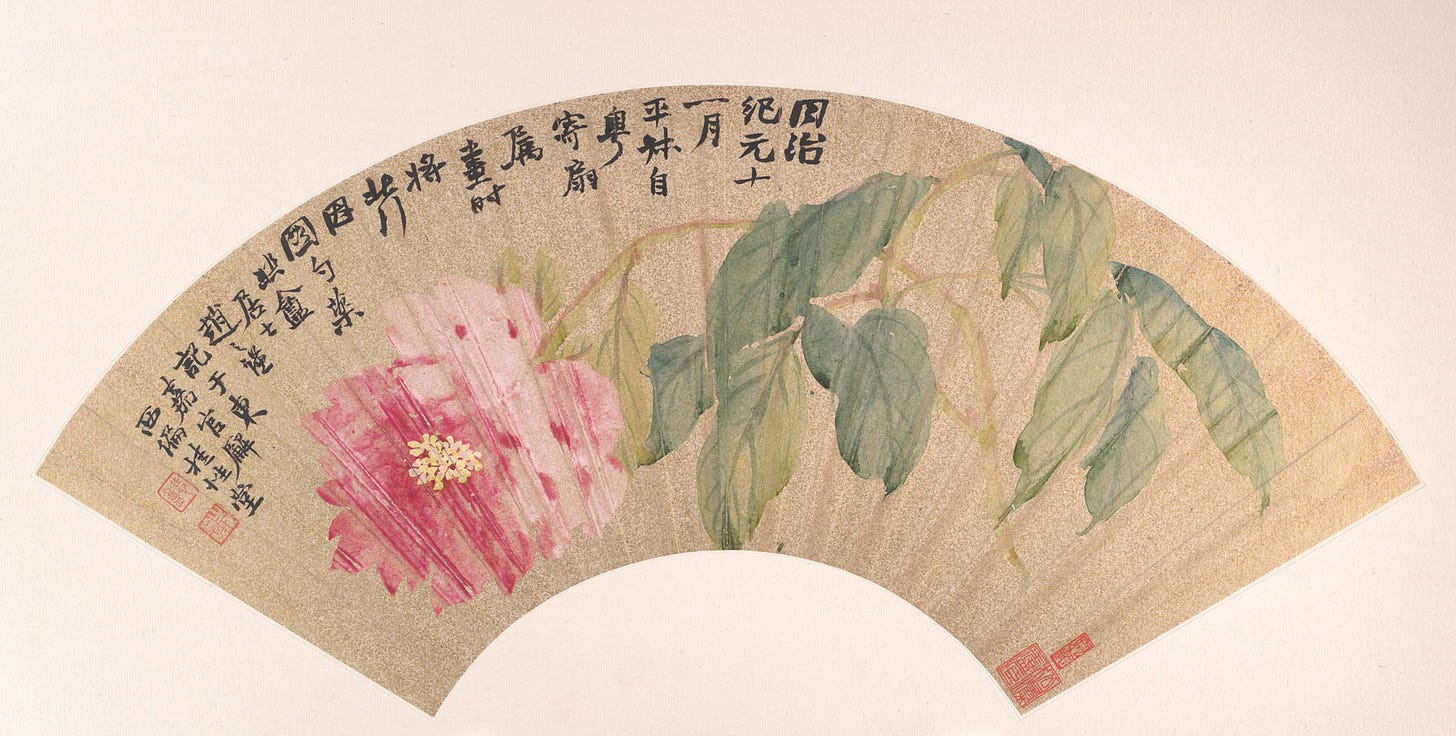This issue looks at views of China from both the inside and the outside as the 100th anniversary of the founding of the Chinese Communist Party approaches next month. The Art Section discusses the royal peony in Chinese art. Reflecting travel in the Covid-19 world we live in, One More Thought takes us into the (scary) world of a three-week hotel quarantine.
China and China’s Communist Party at 100
The 100th anniversary of the founding of the Communist Party of China (the CCP) is fast approaching.1 The official day is July 1st, though the 1st National Congress of the CCP actually opened a few weeks later on July 23, 1921. From modest beginnings (the original Party numbered fewer members than the size of a full deck of playing cards) and through dire early growing pains, the CCP grew and took over China on October 1, 1949. The history of China since then has been tumultuous and consequential.
The China of today is a far more robust nation than it was a century ago. Her economy is second largest in the world, her military is advanced, and the population is literate, well-fed, and richer. The CCP proudly takes credit for this success and strives to ensure its continued dominance through all facets of Chinese society, culture, and life. Control of the narrative is a significant way that this occurs.
So, what is the China of today that the CCP leads?
The View from Inside China. In a recent Sinocism Newsletter, Bill Bishop reported on two front page articles from the official Chinese People’s Daily newspaper. Translating from the first article, entitled “Socialism has not let down China" (社会主义没有辜负中国--党建-中国共产党新闻网), he highlights the following paragraph:
“In the new era of China, the strength of unity goes forward. Facing the peak of science and technology, we never flinch. Chang 'e flew into the sky, the Jiaolong went into the sea, Tianyan watched the stars in the sky, Beidou created a network. Not long ago, the rover Zhu Rong successfully landed on Mars after a 295-day journey. In the face of bullying and suppression, we never gave in. The whole party and the whole country dared to struggle and dared to win, and they gathered together like twisting into a rope. The once-in-a-century Covid-19 pandemic has closely linked the fate of each of us with the fate of the country and the collective. The 1.4 billion Chinese people have joined hands with each other, guarding their homes and protecting their country, creating a great miracle in the history of human struggle against the epidemic....The institutional advantages of socialism have been greatly demonstrated.”
A Chinese State Television review of the second article notes that (also Sinocism translation):
“The article explains the great achievements and historical contributions of the Communist Party of China in leading the people to uphold socialism and develop socialism in the past 100 years from four dimensions: road, theory, system and culture. It is pointed out that the Chinese Communist Party, an unrelenting pathfinder and a brave pioneer, has led the Chinese people out of a socialist road with Chinese characteristics, which is right, feasible, vigorous and promising. It is pointed out that China adheres to the principle of scientific socialism and continuously promotes the sinicization of Marxism. Xi Jinping's socialism with Chinese characteristics in the new era has made an original and contemporary contribution to Marxism. China's system exploration and practice on the socialist road has achieved the miracle of rapid economic development and long-term social stability, and brought unprecedented sense of gain, happiness and security to the people. Socialist culture with Chinese characteristics has been integrated into the spiritual blood of the Party and has become the spiritual pillar of China standing among the nations of the world.”
While the written words drip with florid embellishment, what stands out to me about these paragraphs is that they seem to accurately capture the sentiment of most Chinese people towards China, towards the country’s place in the modern world, and by extension, towards the CCP that has led them here. The details behind the scenes are not so rosy, the history not so illustrious, but the big picture prevails in China as the 100th birthday of the CCP arrives.
The View from Outside China. What about the view from outside China?2 In his talk, “The Superpower Marathon - China vs. the U.S.,” Tufts Political Science Professor Michael Beckley recently expressed the view that, for all her power, China is not in a strong position and that the resulting risk to world peace in the short-term is great.
According to his analysis, China’s principal pitfalls include 1) massive economic waste and a debt crisis resulting from too much credit being extended to the domestic economy over a long time, 2) an environmental crisis, and 3) population decline, all of which are contributing to workforce disruption and a slowdown in growth. Such domestic realities are combined with external realities of stronger, more armed neighbors, the collapse of many Belt and Road Initiative projects in foreign lands, and the fact that much of the world simply does not like the current China. In his opinion, the mix of the above is combustible.
A CCP focused on staying in power is exerting more control at home and more belligerence abroad. Professor Beckley analogizes what is happening in China today with the repeated experience of world history that “when rising powers stop rising, the situation often leads to repression and oppression and war.”
Can both of the above views be correct? I believe that the answer is yes. The question thus becomes will the lurking issues weighing on China as identified in the latter ultimately overcome the belief expressed in the former or will the CCP be able to triumph over these risks in directing China’s future?
The Peony
Chinese art is loaded with symbolism.3 Designs and decorations, either singly or in combination, express wishes for blessings, riches, health, abundance, longevity, children, and more. These symbols include animals, plants, flowers, and fruit, as well as people, inanimate objects, and Chinese characters. In combination, the symbols are called rebuses and serve as puns and metaphors, guides to “hidden meanings” (see below). Alone, they convey their own straightforward meanings.
The peony (牡丹) is one such symbol, and a deeply auspicious one at that. As Terese Tse Bartholomew writes in Hidden Meanings in Chinese Art, “the peony is the most popular botanical motif of China. As the ‘king of flowers,’ it is equivalent to the first rank among officials. The flower is closely associated with royalty because it was grown in the imperial gardens of the Sui and Tang dynasties….The peony is…widely used to symbolize wealth and honor [high rank].”4
An exquisite peony blooms on this vibrant enamel on glass snuff bottle decorated with a yellow background on a gold ground.5 Based on exhaustive Qing Dynasty records, the bottle dates from the period of the Qianlong Emperor, specifically the third month of the fourth year of his sixty-year reign (1739). The Archives indicate that the Emperor personally kept this bottle upon being presented with three for review and approval.6 True to the lineage of the peony (to bring wealth and honor and, when blooming, prosperity), this bottle is a fitting object for an emperor.
Enameling came to China early in the Qing Dynasty (second half of the seventeenth century) from Europe, brought by missionaries and merchant traders. The Kangxi Emperor (the Qianlong Emperor’s grandfather) set up workshops in the Imperial palace to produce glass and enamelware art. Glass snuff bottles were made in the glass workshop, and the plain bottles were then sent to the enamel workshop for painting. While foreign pigments were used initially for this painting, the Chinese ultimately created their own pigments for locally-created enamelware.
The peony is a springtime flower. This peony is from my yard earlier this month. It reminds me of the eighteenth century peony snuff bottle above. The large, marble bud hung around for a couple of weeks before bursting into this gorgeous bloom. A beautiful, auspicious symbol.
One More Thought
I so want to travel back to Asia, but even when I am allowed to fly there once again, there is the quarantine to consider. I could handle a one-week quarantine in a hotel. Two might be pushing it. But three weeks? Pretty sure that would do me in. Check out how these three individuals handled just such a lengthy sequestration when returning to Hong Kong.
Follow Andrew Singer on Social Media: Instagram, Facebook, Twitter.
Photograph of Tiananmen Gate in Beijing by Yangyang on Unsplash
Photograph of Pearl Tower in Shanghai by Jean Beller on Unsplash
Chinese fan by Zhao Zhiqian (1862), Metropolitan Museum of Art, New York
Hidden Meanings in Chinese Art, Terese Tze Bartholomew, Asian Art Museum of San Francisco, 2006
Snuff bottle from National Palace Museum Taipei, Taiwan
See S.L. Tan article in Journal of the International Chinese Snuff Bottle Society, Winter 2020, Pages 22-23 and 27










